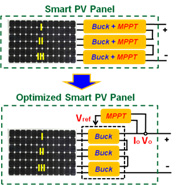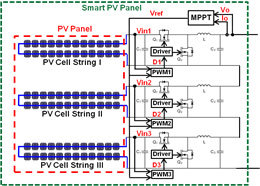RESEARCH
Analysis and Optimization of Smart Panel-Based PV Converter System

The PV panel-level converter decouples the PV panel from other panels, and Fig. 1(b) shows its output curve mapped to a wide MPPT range. Due to safety and device rating issues with the smart converter (SC), voltage limitations and current limitations are added for protection.
Compared with a traditional centralized PV system, as shown in Fig. 2(a), a smart panel-based PV system, as shown in Fig. 2(b), offers advantages such as independent MPPT control, maximized solar power utilization, and flexible system architecture design. Through analyzing principles and the modeling of the smart panel-based PV system, we can determine that the common MPPT region of all the panels remains forever in the range shown in Fig. 2(c); a laxer limitation is shown in Fig. 2(b) for comparison.
Studying a small shading case inside the PV panel, such as bird droppings or a fallen leaf, indicates that this small shading has a disproportionate impact on energy production. A smart converter for PV cell strings is proposed to tackle such problems. Compared with other topologies of smart converters, a series connection of buck subpanel smart converters has been adopted, as shown in the upper part of Fig. 3(a), and the subpanel MPPT structure is optimized, as shown in the lower part of Fig. 3(a), which makes the solution much easier without suffering significant power loss. The detail control diagram is shown in Fig. 3(b).




























































































